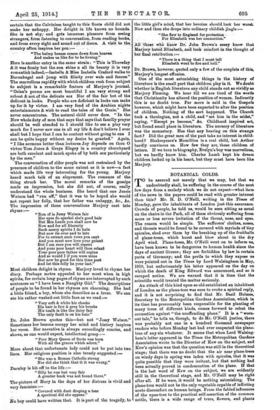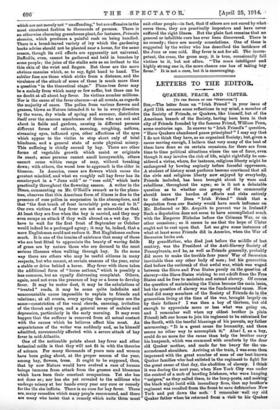BOTANICAL COLDS.
TO be assured not merely that we may, but that we undoubtedly shall, be Buffering in the course of the next few days from a malady which we do not expect—what item of the news in the papers could be read with greater interest than this? Mr. H. D. O'Neill, writing in the Times of Monday, gave the inhabitants of London just this assurance. Crowds of people, be told us, would be seen sitting as usual on the chairs in the Park, all of them obvionaly suffering from more or less severe irritation of the throat, nose, and eyes. The reason would be simple. The sufferers' clothes, noses, and throats would be found to be covered with myriads of tiny spicules, shed over them by the breaking up of the fruitballs of plane-trees, which burst and blow about in the dry April wind. Plane-trees, Mr. O'Neill went on to inform us, have been known to be dangerous to human health since the days of ancient Greece ; they are forbidden by law in certain parts of Germany; and the perils to which they expose us were pointed out in the Times by Lord Walsingham in May, 1910, but unfortunately his letter appeared on the day on which the death of King Edward was announced, and so it escaped notice. We are warned that it is time that the scientific world treated the matter seriously.
An attack of this kind upon so old-established an inhabitant of London as the plane-tree was sure to evoke a spirited reply, and it is not surprising to find that Mr. Basil Holmes, Secretary to the Metropolitan Gardens Association, which in its time has presumably been responsible for the planting of many trees of different kinds, comes forward to rebut the accusation against "the unoffending plane." It is a " worn- out tale," he tells us, though, to do Mr. O'Neill justice, there was probably not one in a hundred thousand newspaper readers who before Monday last had ever suspected the plane. tree of any sin whatever. It seems that when Lord Walsing- ham's letter appeared in the Times the Metropolitan Gardens Association wrote to the Director of Kew on the subject, and Kew's opinion was that the question was still in the theoretical stage; that there was no doubt that the air near plane-trees on windy days in spring was laden with spicules, that it was quite possible that they were irritant, but that nothing had been actually proved in condemnation of the plane. If that is the last word of Kew on the subject, we are evidently still in the theoretical stage, and Mr. O'Neill may be right after all. If he were, it would be nothing astonishing. The plane-tree would not be the only vegetable capable of inflicting acute discomfort on human beings. From the fabled influences of the upas-tree to the practical self-assertion of the common nettle, there is a wide range of trees, flowers, and plants
which are not merely not " nnoffending," but are offensive in the most consistent fashion to thousands of persons. There is an otherwise charming greenhouse plant, for instance, Primula obeonica, which produces a painful rash on being handled. There is a broad-leaved variety of ivy which the gardening books advise should not be planted near a house, for the same reason, though its evil effects are apparently not universal. Daffodils, even, cannot be gathered and held in hunches by some people; the juice of the stalks acts as an irritant to the thin skin of the wrist and fingers. But these are the more obvious enemies which, so to say, fight band to hand. The subtler foes are those which strike from a distance, and the virulence of the attack of some of these is much more than a question "in the theoretical stage." Plane-tree fever may be a malady from which many or few suffer, but there can be no doubt at all about bay fever. Its victims number millions. Nor is the cause of the fever obscure—at all events, as regards the majority of cases. The pollen from various flowers and grasses, blown as Nature intended it to be in every direction by the warm, dry winds of spring and summer, distributes itself over the mucous membranes of those who are out and about in fields and gardens, causing in different persons different forms of catarrh, sneezing, coughing, asthma, streaming eyes, inflamed eyes, other affections of the eyes which appear to the victim to stop short only of total blindness, and a general state of acute physical misery. This suffering is chiefly caused by bay. There are other forms of vegetable growth which assist or originate its onset; some persons cannot smell honeysuckle, others cannot come within range of may, without breaking down; with others, the worst tree to approach is the elder in blossom. In America, roses are flowers which cause the greatest mischief, and what we roughly call hay fever has its counterpart in a " June cold " or " rose cold," which lasts practically throughout the flowering season. A writer in the Times, commenting on Mr. O'Neill's remark as to the plane- tree, observes that this American form of illness is due to the presence of rose pollen in suspension in the atmosphere, and that "the first touch of frost invariably puts an end to it." Our own victims of bay fever are not so miserable as that. At least they are free when the hay is carried, and they may even escape an attack if they walk abroad on a wet day. To have to wait for the first frost of September or October would indeed be a prolonged agony; it may be, indeed, that a mere Englishman could not endure it. But Englishmen endure much. It is one of the ironies of existence that many of those who are best fitted to appreciate the beauty of waving fields of grass are by nature those who are doomed to the most serious illnesses when walking through hay. In the same way there are others who may be useful citizens in many respects, but who cannot, at certain seasons of the year, enter a stable or drive behind a horse. Hay fever with them takes the additional form of "horse asthma," which is possibly a less common, but an equally distressing complaint. Others, again, need not even the presence of bay or a horse to develop fever. It may be motor dust, it may be the exhalations of "treated" roads, it may be some quite indefinite and unaccountable cause impossible to explain to friends and relations; at all events, every spring the symptoms are the same—constriction of the vocal chords, sneezing, irritation of the throat and eyes, and a general sense of malaise and depression, particularly in the early morning. It may even happen that the sufferer is removed from all actual contact with the causes which he believes affect him most. An acquaintance of the writer was suddenly and, as he himself admitted, unreasonably affected with a severe attack of hay fever in mid-Atlantic.
One of the noticeable points about hay fever and other botanical colds is that they will not fit in with the theories of science. For many thousands of years men and women have been going about, at the proper season of the year, among hay, flowers, trees. It ought to be supposed, then, that by now Nature would have evolved a race of human beings immune from attack from the grasses and blossoms which have been their constant companions. Yet she has not done so; nor has she yet revealed to the millions who undergo misery at her hands every year any cure or remedy for the ills she inflicts. There is no cure for bay fever. There are,many remedies which many people recommend, and there are many who insist that a remedy which knits them • =net
suit other people—in fact, that if others are not cured by what cures them, they are practically impostors and have never suffered the right illness. But the plain fact remains that no general or infallible care has ever been discovered. There is no remedy; there are merely consolations. One of these is suggested by the writer who has described the incidence of the June or rose cold. Hay fever is not for all. The incom- petent, the erase, the gross may, it is true, occasionally fall victims to it, but not often. "The more intelligent and highly strung one is, the more chance one has of taking hay fever." It is not a cure, but it is encouraging.



























































 Previous page
Previous page